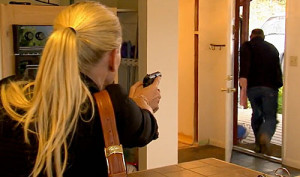Widgetized Section
Go to Admin » Appearance » Widgets » and move Gabfire Widget: Social into that MastheadOverlay zone
What’s Best for Self Defense? A Profoundly Subjective Decision
 You absolutely must be keeping up with the 1911 threads on Modern Service Weapons and elsewhere. Tim Lau at MSM, who has forgotten more about 1911s in the last 30 minutes than I know (and I have spent a bit of time around 1911s!), mentioned that yep, they’re finicky, require maintenance and a few other points that we all know, and you’d think he said John Browning ate babies. It’s all pretty funny and is entertaining reading.
You absolutely must be keeping up with the 1911 threads on Modern Service Weapons and elsewhere. Tim Lau at MSM, who has forgotten more about 1911s in the last 30 minutes than I know (and I have spent a bit of time around 1911s!), mentioned that yep, they’re finicky, require maintenance and a few other points that we all know, and you’d think he said John Browning ate babies. It’s all pretty funny and is entertaining reading.
It does touch on some important issues though, a couple of which me, Janich, Seeklander and Marty Hayes have discussed over the last 2 days while preparing for the next season of The Best Defense. If you’re one of the Down Range Radio listeners, you already know I have a big issue with this whole meme of finding “what’s best” for self-defense. Of course that’s been fodder for the firearms media ever since there was a firearms media (and, in truth, I’ve written heaven knows how many articles over the years on “what’s best,” for which I’m probably doomed to some kind of gunwriter hell).
But over the years I’ve had somewhat of a turnaround. What we choose to defend ourselves with is a profoundly subjective decision. The overwhelming factors in that decision are strictly personal — age, body composition, weight, height, physical condition, level of skill, daily routine, job, commute, commitment, ttime to train or practice, where in the country one lives, federal/state/local laws, children/no children, and on and on. Add all those factors up and you end up with a profile every bit as unique as a fingerprint or a retinal scan.
What is best for me will not be the same as what’s best for Mike Seeklander or for my Sweetie. In fact, “best” is a fallacious concept because there is no set of objective criteria for evaluation that works “across the board,”so to speak. That’s where self-defense training differs from competition training. We know very specifically what a competition guns needs to do because each competition organization has a rule book that not only says how we’ll be scored in the end, but specifies what the targets must look like, where they can be placed, when and how we can engage those targets, which direction we may and may not move, at what point we start and stop, etc. The result of all those specifics allows us to tailor the tool for the specific outcome desired.
In self-defense training, it is the opposite. In fact, any assumptions we might make about the number or physical ability, or mental state of potential “target(s),” the environment in which we have to use our self-defense weapon, our own physical and mental state, etc., have the potential to backfire very badly… perhaps even lethally. One of the most important things I learned in my years in very high-risk sports was that assumptions can and do kill. “Assumptions” are another way of saying that we have created a mental pattern for an event; the danger is when we mistake the pattern for reality (I think I’m badly quoting Bruce Lee here). That mistake creates “lag time” in our reactions. Worst case is the classic “deer in the headlights” — “holy crap what is that bright li…” SPLAT!
Best case is we still lose critical time as we mentally spin from I know what’s going to happen…to wait a minute, it’s not happening that way…to what’s really happening…to what should my response be now. There’s plenty of time in there for a SPLAT.
Given that time is quite literally of the essence, we choose a self-defense tool that is most appropriate to our specific situation because that is the tool we will use most efficiently. As trainers, we understand — or should understand — that any and every choice is a compromise. Like the old dojo line — if you knew you were going to be in a gunfight today and you could not stay home, what would you carry? I’m going for an Apache gunship and a bunch of Seeklander’s friends.
I think the appropriate role for trainers, or at least one of the appropriate roles, show the available options (and certainly suggest the pluses and minuses of each option), help people understand the compromises they are making, then teach how to utilize the chosen tool to minimize the consequences of those compromises. Make sense?
And yes, the 1911 is finicky when compared to modern service pistols. Porsches also require a greater level of skill to drive well than, say, a Chevy Aveo (my aging Honda Element, of course, being the ne plus ultra of performance vehicles).



 MidwayUSA
MidwayUSA Ruger Firearms
Ruger Firearms SCCY Firearms
SCCY Firearms Streamlight
Streamlight Action Targets
Action Targets Gunsite Academy
Gunsite Academy
You must be logged in to post a comment Login